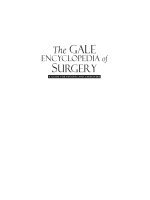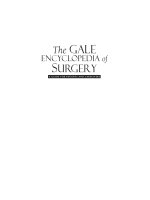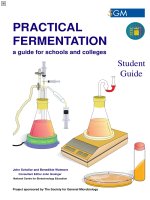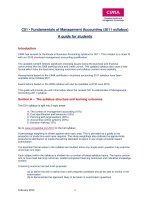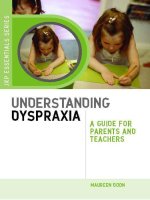cheriet, kharma, liu, suen - character recognition systems. a guide for students and practitioners
Bạn đang xem bản rút gọn của tài liệu. Xem và tải ngay bản đầy đủ của tài liệu tại đây (3.77 MB, 361 trang )
CHARACTER
RECOGNITION SYSTEMS
A Guide for Students and Practioners
MOHAMED CHERIET
´
Ecole de Technologie Sup´erieure/University of Quebec, Montreal
NAWWAF KHARMA
Concordia University, Montreal
CHENG-LIN LIU
Institute of Automation/Chinese Academy of Sciences, Beijing
CHING Y. SUEN
Concordia University, Montreal
CHARACTER
RECOGNITION SYSTEMSCHARACTER
RECOGNITION SYSTEMS
A Guide for Students and Practioners
MOHAMED CHERIET
´
Ecole de Technologie Sup´erieure/University of Quebec, Montreal
NAWWAF KHARMA
Concordia University, Montreal
CHENG-LIN LIU
Institute of Automation/Chinese Academy of Sciences, Beijing
CHING Y. SUEN
Concordia University, Montreal
Copyright © 2007 by John Wiley & Sons, Inc. All rights reserved
Published by John Wiley & Sons, Inc., Hoboken, New Jersey
Published simultaneously in Canada
No part of this publication may be reproduced, stored in a retrieval system, or transmitted in any form or
by any means, electronic, mechanical, photocopying, recording, scanning, or otherwise, except as
permitted under Section 107 or 108 of the 1976 United States Copyright Act, without either the prior
written permission of the Publisher, or authorization through payment of the appropriate per-copy fee to
the Copyright Clearance Center, Inc., 222 Rosewood Drive, Danvers, MA 01923, (978) 750-8400, fax
(978) 750-4470, or on the web at www.copyright.com. Requests to the Publisher for permission should
be addressed to the Permissions Department, John Wiley & Sons, Inc., 111 River Street, Hoboken, NJ
07030, (201) 748-6011, fax (201) 748-6008, or online at />Limit of Liability/Disclaimer of Warranty: While the publisher and author have used their best efforts in
preparing this book, they make no representations or warranties with respect to the accuracy or
completeness of the contents of this book and specifically disclaim any implied warranties of
merchantability or fitness for a particular purpose. No warranty may be created or extended by sales
representatives or written sales materials. The advice and strategies contained herein may not be suitable
for your situation. You should consult with a professional where appropriate. Neither the publisher nor
author shall be liable for any loss of profit or any other commercial damages, including but not limited to
special, incidental, consequential, or other damages.
For general information on our other products and services or for technical support, please contact our
Customer Care Department within the United States at (800) 762-2974, outside the United States at (317)
572-3993 or fax (317) 572-4002.
Wiley also publishes its books in a variety of electronic formats. Some content that appears in print may
not be available in electronic formats. For more information about Wiley products, visit our web site at
.
Wiley Bicentennial Logo: Richard J. Pacifico
Library of Congress Cataloging-in-Publication Data
Character recognition systems : a guide for students and practioners / Mohamed Cheriet [et al.].
p. cm.
Includes bibliographical references and index.
ISBN 978-0-471-41570-1 (cloth)
1. Optical character recognition devices. I. Cheriet, M. (Mohamed)
TA1640.C47 2007
006.4’24–dc22
2007011314
Printed in the United States of America
10987654321
To my parents,
my wife Farida,
my daugters Imane,
Islem and Ihcene
(Mohamed Cheriet)
To my parents Nayef and Fauzieh,
to the children of Palestine
(Nawwaf Kharma)
To my parents,
my wife Linlin,
my son Jiayi
(Cheng-Lin Liu)
To my parents,
my wife Ling,
my sons Karwa and Karnon
(Ching Y. Suen)
CONTENTS
Preface xiii
Acknowledgments xvii
List of Figures xix
List of Tables xxvii
Acronyms xxix
1 Introduction: Character Recognition, Evolution,
and Development 1
1.1 Generation and Recognition of Characters 1
1.2 History of OCR 2
1.3 Development of New Techniques 3
1.4 Recent Trends and Movements 3
1.5 Organization of the Remaining Chapters 3
References 4
2 Tools for Image Preprocessing 5
2.1 Generic Form-Processing System 5
2.2 A Stroke Model for Complex Background Elimination 8
vii
viii CONTENTS
2.2.1 Global Gray Level Thresholding 9
2.2.2 Local Gray Level Thresholding 11
2.2.3 Local Feature Thresholding—Stroke-Based Model 12
2.2.4 Choosing the Most Efficient Character Extraction Method 15
2.2.5 Cleaning Up Form Items Using Stroke-Based Model 19
2.3 A Scale-Space Approach for Visual Data Extraction 21
2.3.1 Image Regularization 22
2.3.2 Data Extraction 24
2.3.3 Concluding Remarks 29
2.4 Data Preprocessing 30
2.4.1 Smoothing and Noise Removal 30
2.4.2 Skew Detection and Correction 32
2.4.3 Slant Correction 34
2.4.4 Character Normalization 36
2.4.5 Contour Tracing/Analysis 41
2.4.6 Thinning 45
2.5 Chapter Summary 50
References 51
3 Feature Extraction, Selection, and Creation 54
3.1 Feature Extraction 54
3.1.1 Moments 55
3.1.2 Histogram 58
3.1.3 Direction Features 59
3.1.4 Image Registration 64
3.1.5 Hough Transform 68
3.1.6 Line-Based Representation 70
3.1.7 Fourier Descriptors 73
3.1.8 Shape Approximation 76
3.1.9 Topological Features 78
3.1.10 Linear Transforms 79
3.1.11 Kernels 86
3.2 Feature Selection for Pattern Classification 90
3.2.1 Review of Feature Selection Methods 90
3.3 Feature Creation for Pattern Classification 104
3.3.1 Categories of Feature Creation 104
3.3.2 Review of Feature Creation Methods 105
3.3.3 Future Trends 118
CONTENTS ix
3.4 Chapter Summary 120
References 120
4 Pattern Classification Methods 129
4.1 Overview of Classification Methods 129
4.2 Statistical Methods 131
4.2.1 Bayes Decision Theory 131
4.2.2 Parametric Methods 132
4.2.3 Nonparametric Methods 138
4.3 Artificial Neural Networks 142
4.3.1 Single-Layer Neural Network 144
4.3.2 Multilayer Perceptron 148
4.3.3 Radial Basis Function Network 152
4.3.4 Polynomial Network 155
4.3.5 Unsupervised Learning 156
4.3.6 Learning Vector Quantization 160
4.4 Support Vector Machines 162
4.4.1 Maximal Margin Classifier 163
4.4.2 Soft Margin and Kernels 165
4.4.3 Implementation Issues 166
4.5 Structural Pattern Recognition 171
4.5.1 Attributed String Matching 172
4.5.2 Attributed Graph Matching 174
4.6 Combining Multiple Classifiers 179
4.6.1 Problem Formulation 180
4.6.2 Combining Discrete Outputs 181
4.6.3 Combining Continuous Outputs 183
4.6.4 Dynamic Classifier Selection 190
4.6.5 Ensemble Generation 190
4.7 A Concrete Example 194
4.8 Chapter Summary 197
References 197
5 Word and String Recognition 204
5.1 Introduction 204
5.2 Character Segmentation 206
5.2.1 Overview of Dissection Techniques 207
5.2.2 Segmentation of Handwritten Digits 210
x CONTENTS
5.3 Classification-Based String Recognition 214
5.3.1 String Classification Model 214
5.3.2 Classifier Design for String Recognition 220
5.3.3 Search Strategies 227
5.3.4 Strategies for Large Vocabulary 234
5.4 HMM-Based Recognition 237
5.4.1 Introduction to HMMs 237
5.4.2 Theory and Implementation 238
5.4.3 Application of HMMs to Text Recognition 243
5.4.4 Implementation Issues 244
5.4.5 Techniques for Improving HMMs’ Performance 247
5.4.6 Summary to HMM-Based Recognition 250
5.5 Holistic Methods for Handwritten Word Recognition 250
5.5.1 Introduction to Holistic Methods 251
5.5.2 Overview of Holistic Methods 255
5.5.3 Summary to Holistic Methods 256
5.6 Chapter Summary 256
References 257
6 Case Studies 263
6.1 Automatically Generating Pattern Recognizers with
Evolutionary Computation 263
6.1.1 Motivation 264
6.1.2 Introduction 264
6.1.3 Hunters and Prey 266
6.1.4 Genetic Algorithm 271
6.1.5 Experiments 272
6.1.6 Analysis 280
6.1.7 Future Directions 281
6.2 Offline Handwritten Chinese Character
Recognition 282
6.2.1 Related Works 283
6.2.2 System Overview 285
6.2.3 Character Normalization 286
6.2.4 Direction Feature Extraction 289
6.2.5 Classification Methods 293
6.2.6 Experiments 293
6.2.7 Concluding Remarks 301
CONTENTS xi
6.3 Segmentation and Recognition of Handwritten
Dates on Canadian Bank Cheques 301
6.3.1 Introduction 302
6.3.2 System Architecture 303
6.3.3 Date Image Segmentation 303
6.3.4 Date Image Recognition 308
6.3.5 Experimental Results 315
6.3.6 Concluding Remarks 317
References 317
Index 321
PREFACE
In modern society, we rely heavily on computers to process huge volumes of data.
Related to this and for economic reasons or business requirements, there is a great
demand for quickly inputting the mountains of printed and handwritten information
into the computer. Often these data exist on paper and they have to be typed into
the computer by human operators, for example, billions of letters in the mail, checks,
payment slips, income taxforms, and many other business forms and documents. Such
time-consuming and error-prone processes have been lightened by the invention of
OCR (optical character recognition) systems that read written data by recognizing
them at high speeds, one character at a time. However, the capabilities of the current
OCR systems are still quite limited and only a small fraction of the above data are
entered into the computer by them. Hence, much effort is still needed to enable them
to read printed and handwritten characters more accurately. This book looks at some
of the problems involved and describes in depth, some possible solutions, and the
latest techniques achieved by researchers in the character recognition field.
Although several OCR books have been published before,
1
none of them are up-
to-date now. In view of this, we have gathered together to write this book. It is our
objective to provide the readers with the fundamental principles and state-of-the-art
computational methods of reading printed texts and handwritten materials. We have
also highlighted the key elements of character recognition
2
with extensive illustrations
and references so that the readers can pursue further research and studies. It is hoped
that this book will help graduate students, professors, researchers, and practitioners
to master the theory and latest methodologies in character recognition, and to apply
them in their research and practice.
1
See references [5] to [7] at the end of Chapter 1.
2
See references [4] to [7] at the end of Chapter 1.
xiii
xiv PREFACE
This book consists of six chapters, each preceded by an introduction and followed
by a comprehensive list of references for further reading and research. These chapters
are summarized below:
Chapter 1 introduces the subject of character recognition, some perspectives on
the history of OCR, its applications, evolution, and a synopsis of the other chapters.
Chapter 2 describes the most widely used preprocessing techniques. An intel-
ligent form processing system is used to illustrate systematically: (a) a scale-based
approach of enhancing the signal-to-noise ratio and (b) an efficient method of ex-
tracting the items-of-interest in a digital text image. This chapter also introduces the
essential smoothing and noise removal techniques and key methods of normalizing
the digitized characters, including the detection and correction of slants and skews,
and the normalization of character sizes and positions. As well, methods of extracting
character contours and skeletons are presented with appropriate illustrations.
All characters and words possess their own salient features. Chapter 3 shows
various ways of extracting these features and evaluating them. Section 1 covers a
large number of features commonly used for character recognition. Both structural
(such as discrete features and geometric shapes) and statistical (such as moments and
Fourier descriptors) features are described. Section 2 examines the relation between
feature selection and classification, and the criteria for evaluating different feature
subsets. Finally, a new concept of feature creation is introduced, and some pointers in
the search for novel features as well as avenues for discovering some unknown ones
are provided.
Chapter 4 presents some modern classification methods that have proven to
be successful in character recognition. They include statistical methods, artificial
neural networks (ANN), support vector machines (SVM), structural methods, and
multi-classifier methods. ANNs and SVMs make use of a feature vector of fixed di-
mensionality mapped from the input patterns. Structural methods recognize patterns
via elastic matching of strings, graphs, or other structural descriptors. Multiclassifier
methods integrate the decisions of several classifiers. This chapter describes, in depth,
the concepts and mathematical formulations of all these methods, and their relations
to Bayesian decision theory, and to parametric and nonparametric methods. It also
discusses their properties and learning procedures. Furthermore, this chapter provides
comprehensive guidelines in implementing practical classifiers and in applying them
to recognize characters. Examples of experimental designs, training procedures, and
testing of real-life databases are also provided.
In real-world applications, documents consist of words or character strings rather
than elementary units of isolated characters. However, word and character string
recognition processes involve character segmentation, character recognition, and con-
textual analyses. Chapter 5 gives an overview of word and string recognition methods,
and techniques related to segmentation and recognition. Both explicit and implicit
segmentation methods are introduced, as well as holistic approaches that make use of
more global features and word modeling. Because hidden Markov models (HMMs)
have frequently been used in the segmentation process, their theoretical background is
treated in a separate section. Implementation issues are also discussed in this chapter.
PREFACE xv
To provide further details about the practical aspects, three case studies have been
included in Chapter 6. The first one illustrates an automatic method of generating
pattern recognizers with evolutionary computation. The second one presents a
real-world Chinese character recognition system. The third shows an automatic
segmentation and recognition system for handwritten dates on Canadian bank
cheques. Each study includes a description of the method and theory behind with
substantial experimental results.
M. Cheriet, N. Kharma,
C L. Liu and C. Y. Suen
Montreal, Quebec
December 2006
ACKNOWLEDGMENTS
This textbook would have not been possible without the significant contributions
from its authors as well as supporting contributors, who helped with the process of
writing this book. The authors wish to thank first the following people for their deep
involvement in writing parts of the book, namely
• Mr. Javad Sadri, who wrote sections 2.4, 5.2.2 and 5.5. He also spent appre-
ciable time for proof reading and creating the index of this book. He con-
tributed in converting the draft of the book to LaTeX format, as well. He is
currently, a postdoctoral research fellow at the Center for Pattern Recognition
and Machine Intelligence (CENPARMI) in Computer Science and Software
Engineering Department of Concordia University, Montreal, Quebec, Canada.
E-mail: j
• Mr. Taras Kowaliw should be acknowledged for his contributions to the case
studies chapter. Ms. Jie YAO should be acknowledged for her contributions to
the feature selection section of the feature selection and creation chapter.
• Mr. Vincent Dor
´
e, Mr. Ayoub Alsarhan and Mrs. Safeya Mamish: doctoral stu-
dents under Prof. Cheriet supervision, should be acknowledged for their valuable
help in generating the index of this book.
• Dr. Xiangyun Ye, a former postdoctoral fellow at CENPARMI, who contributed
to Sections 2.1 and 2.2.
E-mail:
• Dr. Mounim El-Yacoubi, a former postdoctoral fellow at CENPARMI, who
contributed Section 5.4. He is currently a senior researcher at Parascript, LLC,
Boulder, Colorado, USA.
E-mail:
xvii
xviii ACKNOWLEDGMENTS
• Dr. Louisa Lam, a member of CENPARMI and former research associate, who
contributed to Section 6.3, is currently an associate vice-president at the Institute
of Education in Hong Kong.
E-mail:
• Dr. Joanna (Qizhi) Xu, a former PhD candidate and postdoctoral fellow at
CENPARMI, who contributed to Section 6.3. She is currently a research scien-
tist at Smart Technologies Inc., Calgary, Alberta, Canada.
E-mail:
• Ms. Jie Yao and Mr. Taras Kowaliw, PhD candidates, who contributed to Section
6.1. Both are completing their doctoral studies in the Electrical and Computer
Engineering Department, Concordia University, Canada.
In addition, we would like to thank Shira Katz for proofreading numerous sections
of this book.
We are also very grateful to the following organizations for funding our research
programs:
• NSERC: Natural Sciences and Engineering Research Council of Canada
• FCAR: Fonds pour la Formation de Chercheurs et l’Aide a la Recherche
• CFI: Canadian Foundation for Innovations
• NSFC: National Natural Science Foundation of China
• CAS: Chinese Academy of Sciences
• Industrial organizations: A2IA Corp. (Paris, France), Bell Canada, Canada Post
(Ottawa, Canada), DocImage Inc. (Montreal, Canada), Hitachi Ltd. (Tokyo,
Japan), La Poste (French Post, France)
Furthermore, Mohamed Cheriet is particularly grateful to his PhD student Vincent
Dor
´
e for carefully reviewing Chapter 2 and for providing considerable assistance by
typesetting parts of a text in LaTeX.
Cheng-Lin Liu is grateful to his former advisors and colleagues for their help,
collaboration and discussions, particularly to Prof. Ruwei Dai (CAS, China), Prof.
Jin H. Kim (KAIST, Korea), Prof. Masaki Nakagawa (TUAT, Japan), Dr. Hiromichi
Fujisawa and his group in Hitachi Ltd. (Japan), and Prof. George Nagy (RPI, USA).
LIST OF FIGURES
2.1 Overview of an intelligent form-reading system. 7
2.2 Character strokes on different types of background; (a) Simple
background, easy to binarize by global thresholding; (b) Slowly
varying background, can be removed by local thresholding;
(c) Fast varying background, which need to be removed by feature
thresholding. 12
2.3 (a) A subimage of a web page image with light-on-dark text; (b) A
one-dimensional profile taken from the subimage, at the position
marked with blue line; two positive double-edge peaks are detected,
with intensity of DE-1 and DE-2, respectively. The width of the
double-edge detector is W (5 pixels); (c) The light-on-dark
double-edges extracted from (a). 15
2.4 Examples of character extraction from web page images. 16
2.5 Further examples of character extraction from web page images. 17
2.6 Histograms of the stroke widths of handwritings and preprinted
entities obtained from 10 sample form images scanned at 300 DPI. 20
2.7 Removal of preprinted texts. 21
2.8 One-dimensional and two-dimensional profiles of a Gaussian kernel
with variance σ equal to 9 and a mask support of size 11σ.24
2.9 Original images and their segmentation results
using Gaussian kernels. 25
2.10 One-dimensional and two-dimensional profiles of a KCS kernel with
parameters σ = 15 and γ = 5. 27
xix
xx LIST OF FIGURES
2.11 Truncated Gaussian kernel with the same variance and the same mask
support as the KCS kernel shown below and the logarithm of its
magnitude response. 27
2.12 KCS kernel and the logarithm of its magnitude response. 28
2.13 Original form images and their segmentation results using a KCS. 29
2.14 Two 3 by 3 smoothing (averaging) filter masks. The sum of all the
weights (coefficients) in each mask is equal to one. 30
2.15 Examples of filter masks (3 by 3) that are used for smoothing of binary
document images, (b), (c), and (d) are rotated versions of the filter in (a)
by 90
◦
.31
2.16 (a), (b), and (c) Original images; (d), (e), and (f) Smoothed images,
respectively. 31
2.17 Deviation of the baseline of the text from horizontal direction is
called skew. (a) A skewed handwritten word; (b) Skew corrected
handwritten word in (a); (c) A skewed typewritten text; (d) Skew
corrected image in (c). 32
2.18 Sample image and its projection parallel to the text lines. 33
2.19 Sample image and an oblique projection. Notice the uniform
nature of the distribution. 33
2.20 A rotation transformation can correct the skew of the
document image. 34
2.21 Images of handwritten words and handwritten numeral strings, selected
from USPS-CEDAR CDROM1 database. 34
2.22 (a) A digit circumscribed by a tilted rectangle; (b) slant angle
estimation for the digit in (a). 35
2.23 (a) Original digits; (b) slant corrected digits. 36
2.24 (a) Original character; (b) normalized character filled in standard
(normalized) plane. 37
2.25 Character image, horizontal and vertical density projections,
and coordinate functions. 41
2.26 From left: original image, linear normalization, nonlinear
normalization, moment normalization; upper/lower: without/with
slant correction. 41
2.27 (a) 4-neighbors (4-connected); (b) 8-neighbors (8-connected). 42
2.28 Two examples of 4-connected component objects. 42
2.29 (a) An 8-connected component pattern; (b) a pattern that is not 4-
or 8-connected. 43
2.30 (a) Original pattern in black and white format; (b) outer contour
of the pattern; (c) both outer and inner contours of the pattern. 43
2.31 (a) Starting point for contour tracing; (b) contour tracing procedure. 44
LIST OF FIGURES xxi
2.32 Finding the skeleton of a rectangular object: (a) The centers of all the
maximal circles form the skeleton of the object, points A, B are on the
skeleton, but C does not belong to the skeleton; (b) the resulting
skeleton of the rectangular object. 46
2.33 (a) Original pattern; (b) skeleton as a result of thinning. 46
2.34 (a) Original text; (b) skeleton of the text line in (a). 47
2.35 A 3 by 3 window that shows the pixels around P
1
and its
neighboring pixels. 47
2.36 Two examples of computations of functions of A(P
1
), and B(P
1
): in
(a), A(P
1
) = 1, B(P
1
) = 2, and in (b) A(P
1
) = 2, B(P
1
) = 2. 48
2.37 In examples shown in this figure, condition A(P
1
) = 1 is violated, so by
removing P
1
the corresponding patterns will become disconnected. 48
2.38 (a) An example where A(P
2
) = 1; (b) an example where
P
2
· P
4
· P
8
= 0; (c) an example where P
2
· P
4
· P
8
= 0 and
A(P
2
) = 1. 49
2.39 (a) An example where A(P
4
) = 1; (b) an example where
P
2
· P
4
· P
6
= 0; (c) an example where P
2
· P
4
· P
6
= 0 and
A(P
4
) = 1. 49
2.40 (a) and (d) Original images; (b) and (e) skeletons by Hilditch algorithm;
(c) and (f) skeletons by Zhang-Suen algorithm. 50
3.1 (a) Character image; (b) contour of character; (c) orientation
planes; (d) local orientation histograms. 59
3.2 (a) Contour orientatation planes; (b) blurred orientation planes;
(c) sampled values of blurred planes. 61
3.3 Eight chaincode directions. 61
3.4 Pixels in the neighborhood of current pixel “c”. 62
3.5 Sobel masks for gradient. 62
3.6 Gradient vector decomposition. 63
3.7 Orientation planes merged from eight direction planes of gradient
(upper) and their blurred images (lower). 63
3.8 Polar space representation of a straight line. 69
3.9 (a) An end point pixel P
i
; (b) a junction point pixel P
i
.71
3.10 (a) Directional chaincodes; (b) pixel configuration with PM = 3. 72
3.11 Chaincodes: (a) 4-connectivity; (b) 8-connectivity; (c) example. 77
3.12 Bezier curve used in font definition. 77
3.13 Types of feature points: (a) end point; (b) branch point;
(c) cross point. 79
3.14 First and second principal components. 80
3.15 A typical screen plot. 83
3.16 Subspace axes of PCA and LDA for data points of two classes. 85
xxii LIST OF FIGURES
3.17 The four approaches to feature selection. 92
3.18 Feature subset evaluation criteria. 94
3.19 Search space. 99
3.20 Forward search. 100
3.21 The basic schemes of sequential search and parallel search. 102
3.22 A taxonomy of feature selection search strategies. 103
3.23 The space of feature creations methods. 105
3.24 Automatic operator (feature) creation procedure [110]. 106
3.25 A feature detection operator [105]. 107
3.26 A hit-miss matrix and its application to a T pattern [6]. 114
4.1 Voronoi diagram formed by training samples of two classes.
The decision surface is denoted by thick lines. 141
4.2 Model of a neuron. 142
4.3 Single-layer neural network. The bias terms are not shown. 144
4.4 Multilayer perceptron. For simplicity, the bias terms
are not shown. 148
4.5 Radial basis function network. The bias terms of output nodes are not
shown. 153
4.6 Two-dimensional array of nodes for SOM. 159
4.7 Hyperplane classifier for binary classification and margin. 163
4.8 Two shapes of character “2” encoded as strings of sampled points. 174
4.9 Editing path of the strings in Fig. 4.8 and the correspondence
of points. 174
4.10 A character shape and its ARG representation. 175
4.11 Examples of handwritten digits in USPS database. 194
4.12 Test digits corrected by combining PNC and MQDF. The second and
third columns show the confidence values of two classes by PNC, the
fourth and fifth columns show the confidence values of two classes by
MQDF, and the rightmost column shows the final decision. 196
5.1 Overview of word/string recognition methods. 205
5.2 Character strings of different languages and styles (English words and
numeral strings are separated by white space). 207
5.3 Character segmentation by projection analysis. (a) Characters
separable by vertical projection; (b) separation at points of small
projection; (c) separation by projection in the middle zone. 208
5.4 Character segmentation by connected component analysis. Upper:
connected components (left) and segments after merging horizontally
overlapping components. 209
5.5 Cursive word segmentation at visible ligatures (denoted by short
vertical lines) and invisible ligatures (denoted by long vertical lines). 210


